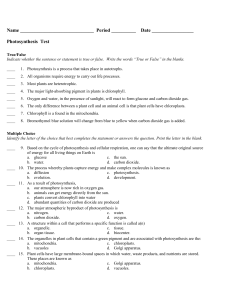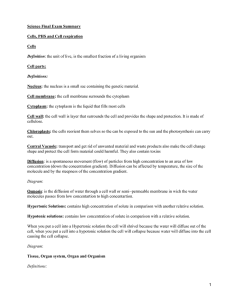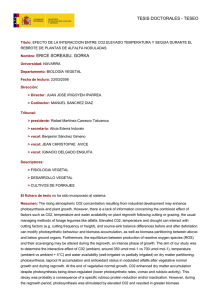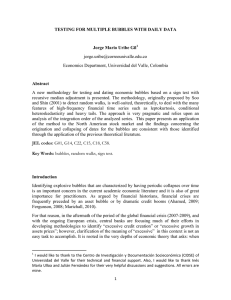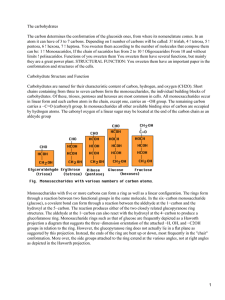Photosynthesis
Anuncio
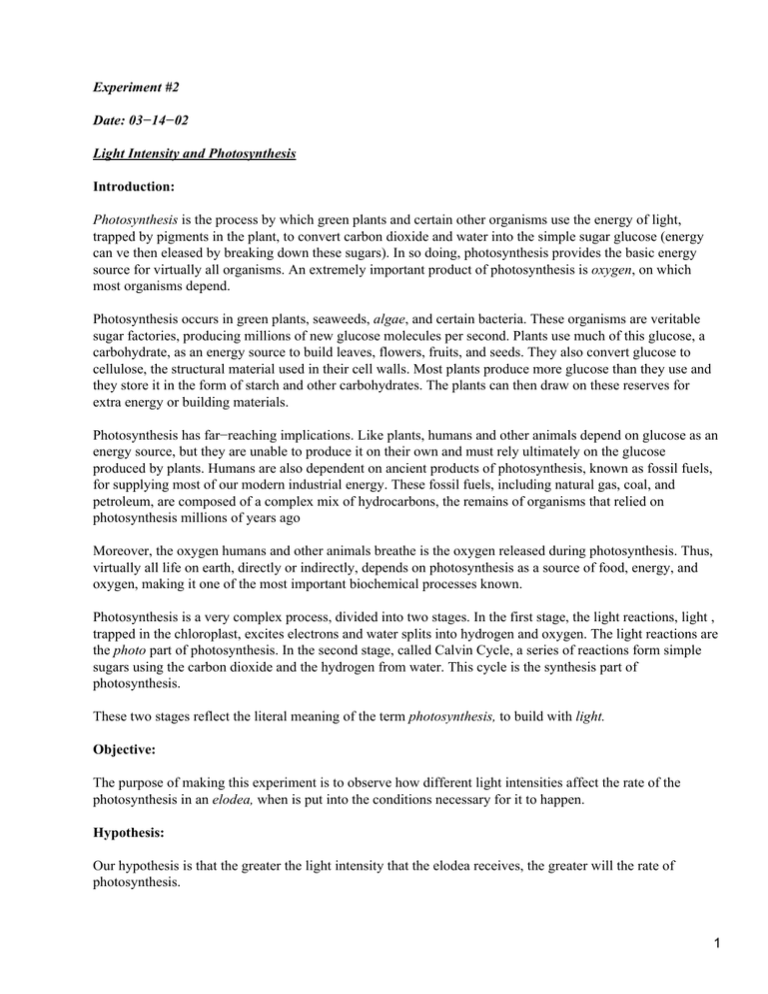
Experiment #2 Date: 03−14−02 Light Intensity and Photosynthesis Introduction: Photosynthesis is the process by which green plants and certain other organisms use the energy of light, trapped by pigments in the plant, to convert carbon dioxide and water into the simple sugar glucose (energy can ve then eleased by breaking down these sugars). In so doing, photosynthesis provides the basic energy source for virtually all organisms. An extremely important product of photosynthesis is oxygen, on which most organisms depend. Photosynthesis occurs in green plants, seaweeds, algae, and certain bacteria. These organisms are veritable sugar factories, producing millions of new glucose molecules per second. Plants use much of this glucose, a carbohydrate, as an energy source to build leaves, flowers, fruits, and seeds. They also convert glucose to cellulose, the structural material used in their cell walls. Most plants produce more glucose than they use and they store it in the form of starch and other carbohydrates. The plants can then draw on these reserves for extra energy or building materials. Photosynthesis has far−reaching implications. Like plants, humans and other animals depend on glucose as an energy source, but they are unable to produce it on their own and must rely ultimately on the glucose produced by plants. Humans are also dependent on ancient products of photosynthesis, known as fossil fuels, for supplying most of our modern industrial energy. These fossil fuels, including natural gas, coal, and petroleum, are composed of a complex mix of hydrocarbons, the remains of organisms that relied on photosynthesis millions of years ago Moreover, the oxygen humans and other animals breathe is the oxygen released during photosynthesis. Thus, virtually all life on earth, directly or indirectly, depends on photosynthesis as a source of food, energy, and oxygen, making it one of the most important biochemical processes known. Photosynthesis is a very complex process, divided into two stages. In the first stage, the light reactions, light , trapped in the chloroplast, excites electrons and water splits into hydrogen and oxygen. The light reactions are the photo part of photosynthesis. In the second stage, called Calvin Cycle, a series of reactions form simple sugars using the carbon dioxide and the hydrogen from water. This cycle is the synthesis part of photosynthesis. These two stages reflect the literal meaning of the term photosynthesis, to build with light. Objective: The purpose of making this experiment is to observe how different light intensities affect the rate of the photosynthesis in an elodea, when is put into the conditions necessary for it to happen. Hypothesis: Our hypothesis is that the greater the light intensity that the elodea receives, the greater will the rate of photosynthesis. 1 Data and Observations: Light Conditions Direct light from a Lamp Normal room light Time the elodea was under the Number of bubbles produced Light 20 min. 3 bubbles 5 min. 0 bubbles We observed that the elodea needed a great amount of light and a lot of time to start making the photosynthesis process and start producing bubbles, and that when it was under normal light conditions it didn't produce any bubbles at all. Answers to Questions: • From where did the bubbles emerge? The bubbles emerged from the top part of the stem of the elodea, and stayed inside the test tube. • When was the number of bubbles produced the most? The few bubbles that were produced by the elodea, were produced when the it was receiving the light from the lamp, and when it was receiving just the normal light it didn't produce any bubbles at all. • Explain how counting bubbles measures the rate of photosynthesis The number of bubbles explains the rate of photosynthesis because the bubbles are oxygen that the plant releases, so the more the bubbles (oxygen) the greater the rate of photosynthesis in the elodea. • What was the purpose of placing the test tube in beaker of solution? The purpose of placing the test tube in the sodium bicarbonate solution was to let the algae receive all the carbon dioxide (substituted by the solution) that it needed. • How might you prove that the bubbles were oxygen? We could prove that the bubbles were oxygen because we know that the waste products of photosynthesis are glucose and oxygen, but oxygen is the only one that is a gas and might form bubbles, so obviously the bubbles are oxygen. • Did your results support your hypothesis? Explain why they did or did not. Our hypothesis turned out to be correct because, as our results show when the elodea was in the normal light it did not produce any bubbles (that means that it was not doing photosynthesis, or very few. But when we placed the algae under the lamp, so that it could receive more light, then was when it starred producing more oxygen (in the form of bubbles), so we knew then the rate of photosynthesis had increased. • Suggest a way of testing the effect of light color on photosynthesis. We really do not know for sure if the light colour has an effect on photosynthesis or if the only thing that affects it is the intensity of that light. However, we could try to taste that by placing the elodea under different light bulbs with different colours of light and observe how the plant reacts under them. Conclusion: How does light intensity affect the rate of photosynthesis? 2 The light intensity affects the rate of photosynthesis because the more the light the more the bubbles that are produced, so the greater the rate of photosynthesis, and the less the light the smaller the rate of photosynthesis. This happens because the light from the lamp can be substituting the solar energy on which photosynthesis depends and the more the energy that the plant trapps the more glucose and oxygen that it can produce. Bibliography: Microsoft® Encarta® Encyclopedia 2000. © 1993−1999 Microsoft Corporation. BIGGS, Alton L. et al. Biology the Dynamics of Life. Ohio. Merril.1991.850pp 3
